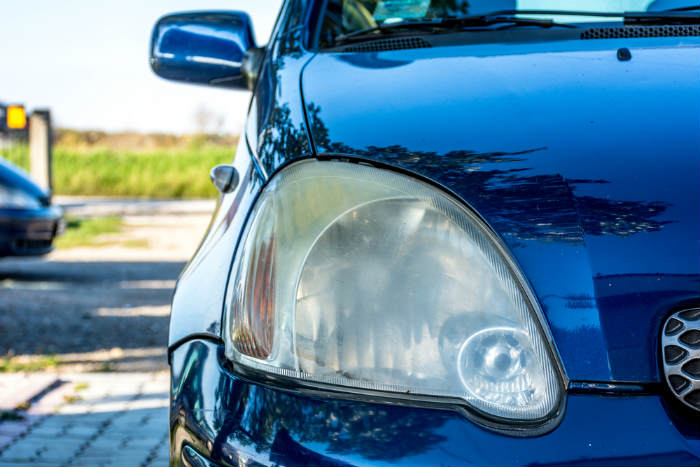2 Minute Trick To Clean/De-Haze Headlights

Make sure to like Living Green and Frugally on Facebook, Shop at amazon to help support my site and explore our PINTEREST BOARDS for innovative ways you can become self-sufficient.
Headlight Restoration Using Toothpaste: Brighten Your Headlights in Minutes!
If your headlights are looking cloudy or yellowed, don’t rush to buy expensive cleaning kits or even new headlights. There’s an easy, budget-friendly way to bring back their shine using a household staple you probably already have in your bathroom: toothpaste! Headlight restoration using toothpaste is not only effective but also quick, safe, and incredibly affordable.
In this guide, we’ll cover why headlights get foggy, step-by-step instructions for restoring them with toothpaste, tips for lasting results, and answers to some of the most common questions about this method.
Why Do Headlights Become Cloudy?
Headlights can become foggy or yellowed over time due to exposure to sunlight, dust, and pollution. These environmental factors cause the protective plastic coating to wear down, leaving a layer of oxidation that makes the headlights appear dull. Cloudy headlights reduce the effectiveness of your car’s lights, impacting your nighttime visibility and safety. Toothpaste, with its gentle abrasives, can scrub off that layer of oxidation, restoring clarity.
Headlight Restoration Using Toothpaste: Step-By-Step Recipe
What You’ll Need:
- Toothpaste (choose a paste with baking soda or whitening agents for best results, avoid gels)
- Water
- Soft cloth or microfiber towel
- Spray bottle (optional)
- Masking tape (optional, but useful for protecting your car’s paint)
- Clear car wax (optional, for added protection)
Steps:
- Clean the Headlight Surface:
- Wipe down the headlights with water and a soft cloth to remove any dirt or debris.
- If you’re worried about scratching the surrounding paint, use masking tape to create a protective barrier around the headlight.
- Apply the Toothpaste:
- Squeeze a generous amount of toothpaste onto a damp cloth or directly onto the headlight.
- Rub the toothpaste in circular motions across the entire headlight surface, applying light pressure. The abrasives in the toothpaste will scrub off the cloudy layer.
- Rinse and Wipe:
- After a few minutes of scrubbing, spray water on the headlight or pour a small amount of water to rinse off the toothpaste.
- Use a clean, damp cloth to wipe away any remaining toothpaste residue.
- Dry and Inspect:
- Wipe the headlight dry with a microfiber towel. Check if any cloudy spots remain; if so, repeat the process as needed.
- Optional: Apply Wax:
- For long-lasting results, apply a thin layer of clear car wax to the headlight. This step will help protect the headlights from future oxidation.
Tips for Effective Toothpaste Headlight Restoration
- Choose the Right Toothpaste: A plain white toothpaste with baking soda or a whitening formula will be more effective than gel toothpaste, as it’s slightly more abrasive.
- Be Patient and Persistent: If the headlights are severely clouded, it may take a couple of applications to fully restore them.
- Apply Car Wax for Extra Protection: After cleaning, a thin layer of car wax or sealant will help slow down future oxidation, keeping your headlights clearer for longer.
- Check for UV Protection: Consider using a UV protectant spray if you live in a very sunny climate, as prolonged UV exposure accelerates clouding.
Common Questions About Using Toothpaste for Headlight Restoration
Q: Can I use any type of toothpaste for this?
A: Not all toothpastes will work equally well. Whitening or baking soda toothpastes have slight abrasives, which are what make them effective. Gel toothpastes usually don’t have enough grit to tackle oxidation, so they may not work as well.
Q: How long does this treatment last?
A: Results vary depending on climate, exposure to sun, and if a protective wax or UV coating is applied afterward. Generally, you might see clear headlights for several months to a year before clouding returns.
Q: Will toothpaste damage my car’s paint?
A: Toothpaste isn’t likely to damage paint if used with care. However, to be safe, protect the paint surrounding the headlights with masking tape or wipe off any excess toothpaste that might accidentally reach the paint.
Q: Can I use baking soda instead of toothpaste?
A: Yes, baking soda mixed with a little water can also be used to clean headlights, but toothpaste often combines baking soda with additional cleaning agents that help enhance results.
Q: Should I replace my headlights if they keep clouding up?
A: Toothpaste restoration is a temporary solution. If your headlights are severely clouded or continually require restoration, it might be more efficient in the long run to replace them or invest in a more permanent restoration kit.
Final Thoughts
Toothpaste headlight restoration is a quick, inexpensive way to get rid of foggy headlights. Not only will your car look better, but you’ll also improve visibility for safer night driving. Keep in mind that this method may need to be repeated over time as oxidation naturally builds up again, but it’s a simple DIY solution to brighten up your ride without a trip to the auto shop.
Now that you know the power of toothpaste goes beyond dental care, give this hack a try and enjoy a brighter, clearer drive!
Pin for Later
